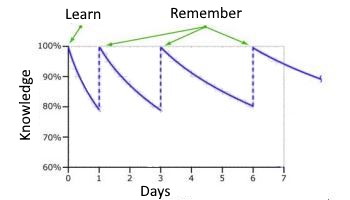
Example
An example makes it clear how spaced repetition works:- You learn the word for the first time. Make sure that you learn it well enough to still remember it the next day.
- After one day you test yourself on the word. If you get it right, you will now remember the word for a bit longer.
- Two days later you test yourself again. If you got it right then you already know the word quite well.
- After another three days you test yourself again.
- Six days later you test yourself again.
- Etc

Side effect: fun learning
With perfectly spaced repetition you learn extremely efficiently. A welcome side effect of perfectly spaced repetition is that it makes learning fun. A simple test is therefore neither too easy, nor too difficult, but challenging. You get a feeling of satisfaction when you know most of the answers in a test, but do have to put some effort into remembering everything. You will notice that you learn quickly which also provides extra motivation. You are learning well if you get a maximum of 10% of your words wrong. However, it’s better to only get a couple of percent wrong and get through your test a bit quicker.

Learn frequently for a short while
In order to test yourself at all the right times it is important that you study frequently for a short while. If you do this, the tests will happen at the right time and you will remember everything. If you learn a list of words which you test yourself on once four days later, it is quite possible that you will have forgotten everything. You can learn it afresh but with the chance that you will have forgotten it again four days later. You need to study every day in order to benefit from the spaced repetition and remember what you have learned in the long-term.
Spaced repetition works
It is a fact that spaced repetition works. Over fifty years (1) of research has gone into this and it is a proven fact ‘Hundreds of studies in cognitive and educational psychology have demonstrated that spacing out repeated encounters with the material over time produces superior long-term learning, compared with repetitions that are massed together.‘(2) And the beauty is that, with the help of a computer, learning through spaced repetition is very easy to do. Do use a teaching program that works through spaced repetition such as Wozzol.
The following film will explain where you can see the use of spaced repetition adapted personally to you in Wozzol.
References and further reading
- DP Ausubel, M Youssef (1965). The effect of spaced repetition on meaningful retention. The Journal of General Psychology, Pages 147-150.
- Kang, S. H. K. (2016). Spaced Repetition Promotes Efficient and Effective Learning: Policy Implications for Instruction. Policy Insights from the Behavioral and Brain Sciences, Vol 3, Issue 1, 2016
- The Guardian: Spaced repetition: a hack to make your brain store information
- Infographics: Studying vs cramming
- Weten en vergeten
- Infographics: Memory retention and the forgetting curve